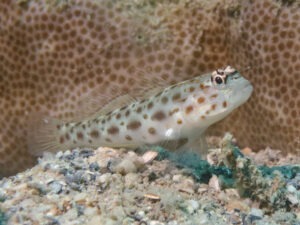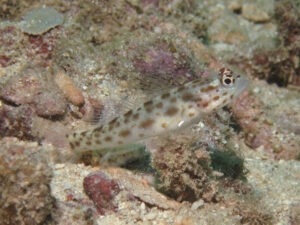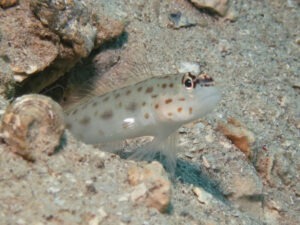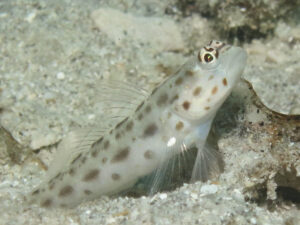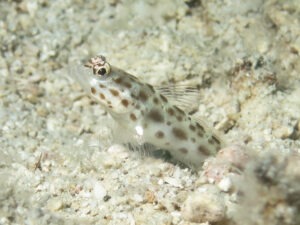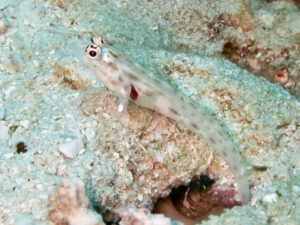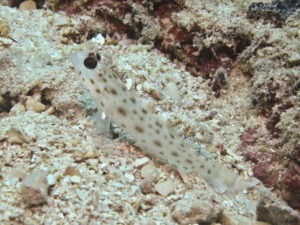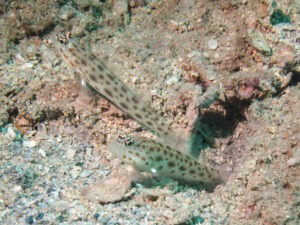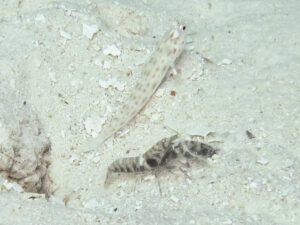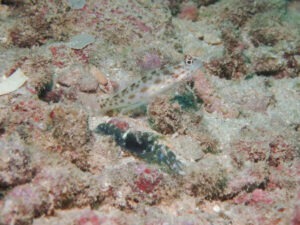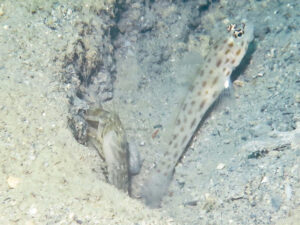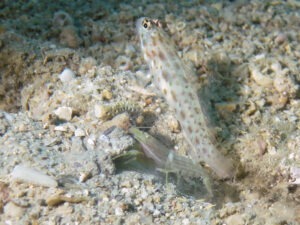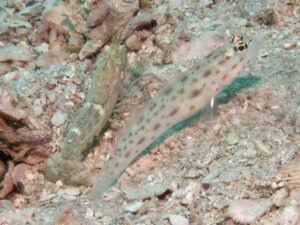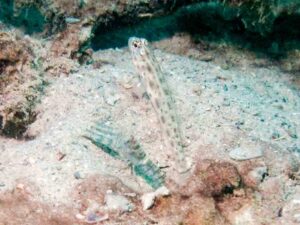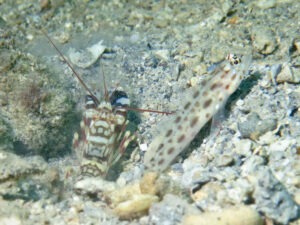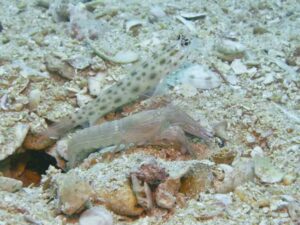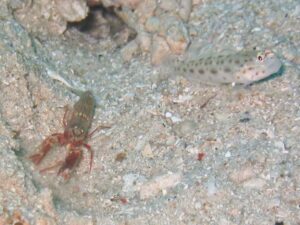Goldspeckled Shrimpgoby
Ctenogobiops pomastictus
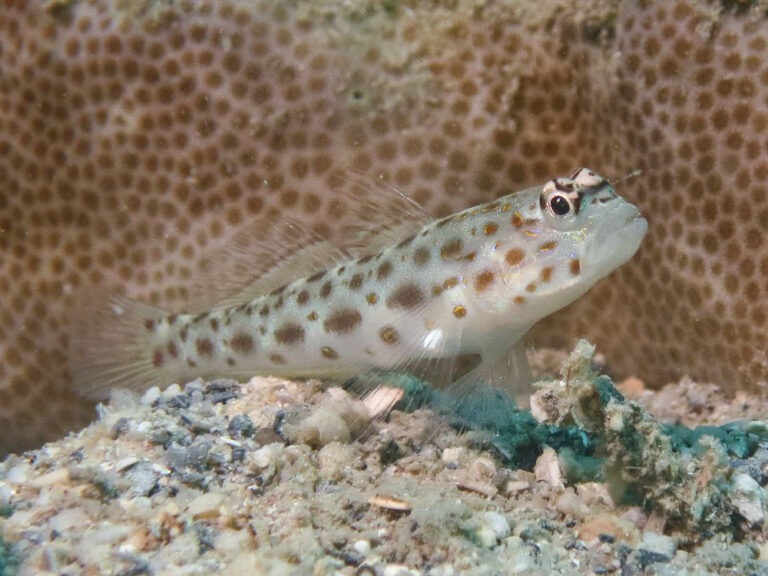
Goldspeckled Shrimpgoby
Ctenogobiops pomastictus
Lubbock and Polunin, 1977
Description
Body design
This is a large goby for its genus, growing to about 10 cm, though small individuals are common. It is white with a series of oval brown patches along the body. The lateral patches are brown with an ill-defined border. With strong illumination, they are encircled by fine blue reflective spots. These have orange spots in the spaces above and below the line of the patches. The lower row of spots is larger, orange with a dark outline and is a useful identifying character.
The face is plain anterior to the eye and decorated behind this with rows of spots that tend to coalesce into horizontal lines. These spots are in two rows, the first spot of the upper row is below the posterior edge of the eye and the last on the opercle; the second row commences with a spot above the rear end of the maxilla and the remaining two or three spots curve ventrally as they pass posteriorly. This contrasts with C mitodes which have a single row of three spots that slope slightly upwards from the maxilla to the opercle. These may be coalesced into a line. (Thacker et al 2010, Randall et al 2007)
Fin design
The fins are all transparent apart from a white patch on the pectoral fin base.
Diagnostic features
The best identification feature is the presence of a series of orange spots, often with a dark border, between and below the lateral patches
The two rows of spots on the cheek, one in a straight line, and one curved, are useful features.
Similar species
Differs from the similar Ctenogobiops mitodes in having two rows of brown spots on the cheek (vs. a single row) and in lacking an elongate second dorsal-fin spine.
C tongaensis is considered by Thacker (2010) to be similar and said to be found on Lizard Island, Great Barrier Reef, and included in her phylogeny. We are not convinced and feel that her phylogeny is flawed by leaving out C pomastictus which is the most commonly seen species in Queensland.
The species of Ctenogobiops may be difficult to tell apart. Apart from C tangaroai, with its distinctive dorsal fin, they are differentiated by head and body patterns.
Head patterns
C aurocingulus 16 bright orange markings in four rows of four in the shape of a trapezoid starting at the angle of the jaw
C feroculus. There is no head pattern.
C crocineus is a series of broken diagonal lines covering the whole area from the nose to the gill covers.
C mitodes Three spots in a straight line along a skin fold running back and upwards from the angle of the mandible
C pomastictus three spots curving ventrally, running back from the angle of the mandible. Above these, there are three spots in a horizontal straight line below the level of the eye.
Body patterns
C aurocingulus Fine gold bars running through lateral patches
C feroculus. Poorly defined lateral patches only
C crocineus Lateral decorations arranged in parallel lines
C mitodes Small brown spots below the level of lateral patches
C pomastictus Dark-outlined orange spots below patches
Other Common Names
Gold-specked Prawn-goby, Gold-speckled Shrimpgoby, Pop-eyed Shrimp-goby, Spotfin Shrimp Goby, Spotted Shrimp Goby, Spotted Shrimpgoby
Etymology
The specific name pomastictus is from the Greek poma (= lid) and stictus (= spotted) in reference to the distinctive colour pattern of the operculum. Bray 2021.
Natural History
Habitat
2 to 25 m depth. Widespread in shallow and moderately deep water on sand but always close to the reef or rocky outcrops. Continental and atoll islands.
Behaviour
This is a familiar goby in shallow water but is by no means restricted to this environment. It manages to live in a range of depths by associating with a wide range of shrimps. Throughout the depth range, it remains close to the reef. In some places, such as Lizard Island, Australia, it grows to an unexpectedly large size.
Eye colour
Like others of this genus, it readily assumes a black surround to the eye.
Parasites
The nudibranch Gymnodoris nigricolor parasitises this shrimpgoby.
Black nudibranch Gymnodoris nigricolor #2520 – 1 and 2 (Add photo)
Distribution
Published distribution
The Andaman Sea to Australia (Queensland, One Tree Island; and Northwest shelf Ashmore reef, Rowley shoals, Coral Bay) and the Solomon Islands northwards to Mariana and the Ryukyu Islands to New Caledonia, ranges throughout the East Indian region. (AE) (R)
Our records
Indonesia; Waigeo and Batanta Islands in Rajah Ampat.
Solomon Islands; Gizo, Kolombangara, Isabel and Nggela Islands.
Papua New Guinea; Hermit Islnds.
Australia; Lizard, Fitzroy, Low and Whitsunday Islands, Ribbon Reefs, Great Barrier Reef
Associated Shrimp species
Associated Shrimps (eleven Shrimps).
Banded Snapping Shrimp, Alpheus species 1
Black-sided Snapping Shrimp, Alpheus cf djeddensis
Brown Pyjama Snapping Shrimp, Alpheus ochrostriatus
Dark Marbled Snapping Shrimp, Alpheus macellarius
Diagonal Barred Snapping Shrimp, Alpheus rapacida
Green Snapping Shrimp, Alpheus species 4
Pale Marbled Snapping Shrimp, Alpheus djiboutensis
Pink Pyjama Snapping Shrimp, Alpheus ochrostriatus
Red Pyjama Snapping Shrimp, Alpheus ochrostriatus
Tiger Snapping Shrimp, Alpheus bellulus
Yellow Pyjama Snapping Shrimp, Alpheus ochrostriatus

